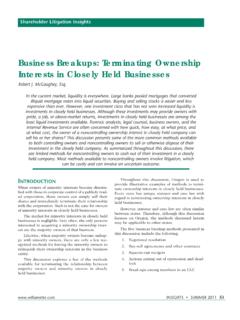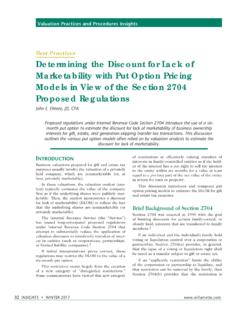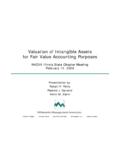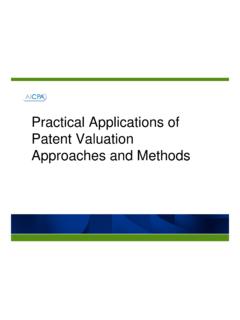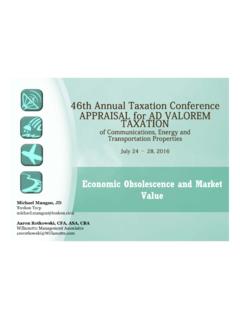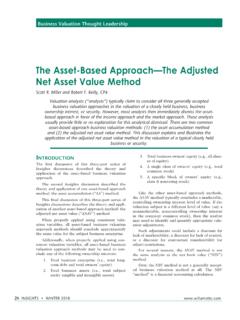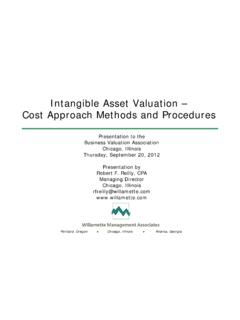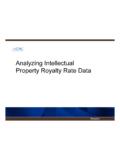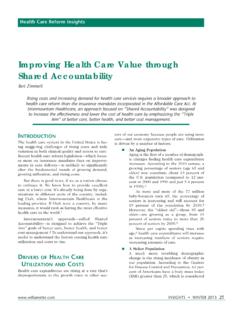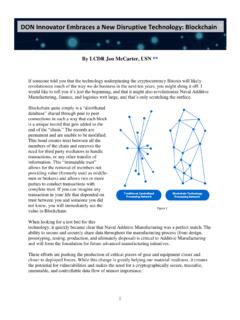Transcription of Embracing Ethics And Morality - Business Valuation Firm
1 EmbracingEthicsAndMoralityPlus CEOs, CFOs, and Fraud Valuing Private Company Stock What Investors Want from Audit ReportsAn Analytic Essay for the Accounting ProfessionPublisherJOANNE S. BARRYArt DirectorLARRY MATTHEWSG raphic Design ManagerERNESTO LARAC opyeditors/ProofreadersGENE CIOFFICHRISTOPHER DAVISA dvertising Account ExecutivesEXECUTIVE PUBLISHING(410) 893-8003 Fax: (410) 893-8004 MOLLY AdvertisingSALES DESK(410) KRANACHER, MBA, CPA/CFF, CFEM anaging Editor CAROLYN MORRISROEA ssociate Editor ANTHONY H. SARMIENTOP ublishing AssistantCHRISTINA DOKAS ubscriptions(800) 877-4522or(212) 719-8312 General Information(212) 719-8300 : CPA Journalwelcomes the submis-sion of articles on a wide variety of top-ics of interest to CPAs in public practice,industry, education, and are evaluated on the basis of theclarity of ideas and writing, contributionto the profession, relevance, benefit topractitioners, and soundness of point ofview.
2 Manuscripts deemed to havepotential for publication are reviewed bytwo referees prior to acceptance for pub-lication. See for more detailed CPA JOURNAL(ISSN 0732-8435, USPS 049-970) is published monthly by The New York StateSociety of Certified Public Accountants, 3 Park Avenue, New York, NY 10016-5991. Copyright 2012 by TheNew York State Society of Certified Public Accountants. Subscription rates: NYSSCPA Members (BasicRate): $ Non-members, United States possessions, Canada, one year $ ; Students (Undergraduateand Graduate) $ ; Foreign $ ; Single copy $ All sub scriptions and remittances may be sent inUnited States funds to The CPA Journal, The New York State Society of Certified Public Accountants, Box 10489, Uniondale, NY 11555-0489.
3 Periodicals postage paid at New York, NY and additionalmailing offices. The matters contained in this publication, unless otherwise stated, are the statements andopinions of their authors and are not promulgations by the Soci ety. Publishers Copy Protection Clause:Advertisers and advertising agencies assume liability for all con tent (including text, representation, andillustrations) herefrom made against the publisher. POSTMASTER: Please send address changes to: TheCPA Journal, 3 Park Avenue, New York, NY 10016-5991, Attn: Sub scription Department. The CPA Journalis a registered trademark of The New York State Society of B. AndersC. Richard BakerWilliam BregmanThomas BuckhoffDouglas R.
4 Carmichael Robert H. ColsonRobert A. DysonAndrew FairJulie Lynn FlochDan L. GoldwasserKenneth J. GralakNeville GrusdElliot L. HendlerNeal B. HitzigRonald J. HuefnerPeter A. Karl IIIL aurence KeiserStuart KesslerMichael KratenJoel LanzMark H. LevinMichele Mark LevineMartin LiebermanDavid A. LifsonSteve LilienSteve LoebVincent J. LoveNicholas J. Mastracchio, B. MorrisBruce NearonRaymond M. NowickiPaul A. PacterLawrence A. PollackArthur J. RadinStephen F. Ryan IIIS tephen ScarpatiRona L. ShorArthur SiegelLynn TurnerElizabeth K. VenutiGeorge I. VictorPaul D. WarnerRobert N. WaxmanTHE CPA JOURNAL EDITORIAL BOARD Participating in one or more of the Society s 60statewide committees is one ofthe most effective ways for youto practice and perfect yourskills and knowledge while contributing to your serviceallows you to: Build leadership skills Network with peers and use your affiliation as an invaluable referral source Gain recognition for you and your organization Stay up to date on current issues Enhance your technical proficiency and career potential Serve your profession and community at largeIt s simple to join a committee.
5 Apply online at and click on Find Committees on the homepage. Or contact Nereida Gomez, Manager of Committees and Administrative Services, at 212-719-8358 or york state society ofcertified public accountantsAccountants often assist closely held corporations (and theirowners) with the planning, negotiation, and execution ofthe sale of company stock. CPAs often assist a closely heldcompany with the taxation, structuring, financial plan-ning, Valuation , and other aspects of the stock sale owners of a closely held company may sell their stock toobtain liquidity, diversify their wealth, manage their estates, startan ownership transition plan, reward and retain key employees,motivate strategic partners, and fulfill other closely held corporation owners elect to sell private com-pany stock to their employees through an employee stock owner-ship plan (ESOP).
6 Some owners elect to sell private companystock directly to employees, to vendors and suppliers, to private equi-ty investors, to financing sources, and to other strategic partners. Insuch cases, CPAs may assist closely held Business owners with anESOP feasibility analysis, with advice on related taxation andfinancial accounting considerations, with stock Valuation analyses,and with the negotiation of the stock purchase , accountants should be generally familiar with thebasics of private company Valuation and private company stock saletransactions. As a private company s most trusted advisor, a CPAmay work with the company s legal counsel and Valuation analystSale of Private Company Stock to Employees and Other PartiesFINANCE Business valuationJANUARY 2012 / THE CPA JOURNAL46By Robert F.
7 Reillyto structure stock sales that benefit thecompany, the selling stockholders, and theemployees and other , the discussion below summarizesthe generally accepted Valuation approach-es with regard to private company Valuation approaches apply to sales ofprivate company stock to an ESOP or to anyother investor. In particular, this discussionconsiders the Valuation factors related tothe level of value, the stock rights and priv-ileges, and the level at which funds are trans-ferred from the private company to theESOP. These factors affect the value of allprivate company stock sold or transferredto all parties (including the ESOP).Second, the discussion below summarizesthe Valuation considerations in an analysisof private company stock sales to anESOP, as opposed to other parties.
8 Thisdiscussion focuses on the many reasons whytwo company stock sales that occur on thesame day may transact at two differentprices. Such an occurrence can be both fairto the ESOP and in compliance with legaland regulatory requirements. Such pricedifferences may be due to differences inthe private company securities ( , votingstock versus non-voting stock) or differencesin the size of the block of closely held cor-poration stock. It may also be reasonable thattwo identical blocks of stock could be soldon the same day at two different prices forexample, one block sold to the ESOP andone block sold to a key employee. This dis-cussion explains some of the reasons for sucha pricing in Private Company StockSales to an ESOPIn addition to the generally accepted con-siderations that apply to any Business valua-tion, there are three considerations that maymake the Valuation of the private companyshares to be sold to an ESOP different froman otherwise identical block of stock: Level of value to apply in the Valuation Contractual rights and privileges relat-ed to the ESOP Financing of the ESOP purchase of theprivate stock.
9 Valuation Approaches and MethodsThere are three generally acceptedapproaches to the Valuation of a privatecompany. Many closely held corporationowners may tell their accountant that thereare specific rules of thumb or unique short-cut formulas that are only applicable tocompanies in the subject industry. Theserules or formulas often relate to a pricingmultiple that is applied to a company-spe-cific metric. For example, industry-specif-ic formulas may include the following: multiple annual revenue multiple annual earnings before inter-est, taxes, depreciation, and amortization(EBITDA) multiple number of customers. When one examines these so-calledindustry rules of thumb, they may be cat-egorized into the following three general-ly accepted Valuation approaches: Income approach Market approach Asset approach.
10 Income ApproachThe income approach is based on theprinciple that the value of the stock is thepresent value of the future incomeexpected to be earned by the companyowners. There are many different ways tomeasure income for Valuation purposes,including the following: Net operating income EBITDA Earnings before interest and taxes(EBIT) Pretax net income After-tax net income Net cash flow. Each of these measures of private com-pany income may be applicable to the val-uation, as long as the discount rate or capi-talization rate corresponds to the selectedbenefit stream. A discount rate (also calleda present value discount rate) is therequired rate of return on an investment inthe private company.
